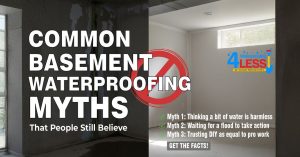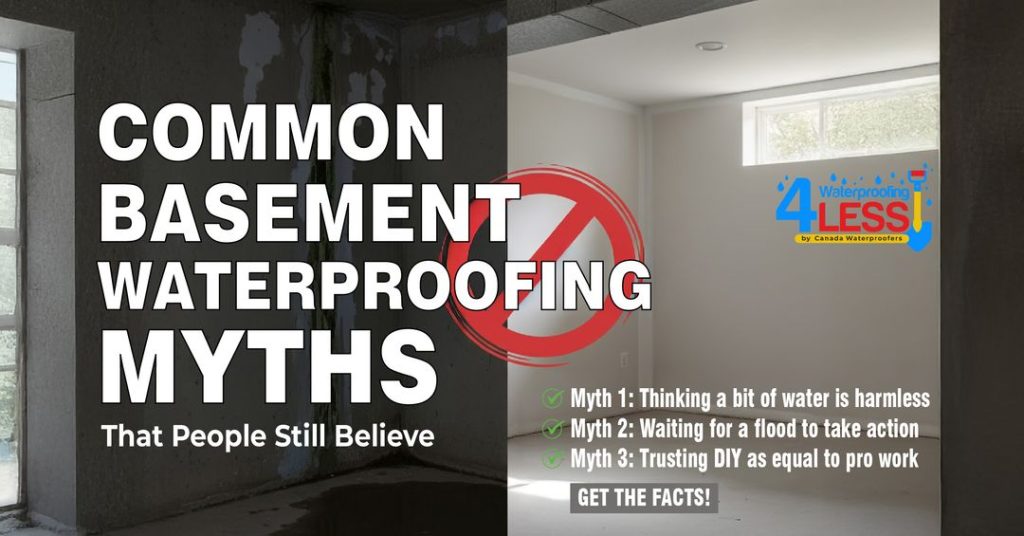
Common Basement Waterproofing Myths That People Still Believe
Think waterproofing is only needed when you see water? Learn why this belief can lead to costly damage. Discover how proactive measures protect your GTA home from hidden moisture issues.
People share a lot of tips about waterproofing, and some of them sound reasonable. But a fair number of those “facts” are actually myths. Believing them doesn’t just waste time – it can quietly set you up for expensive repairs down the road. Let’s straighten them out.
This is where most people go wrong. Even a small damp patch is a signal that something’s off. A basement isn’t supposed to be “a little wet.” It’s meant to stay dry, full stop.
Moisture spreads gradually. First, there’s a stain. Then peeling paint, musty air, and finally mold or structural issues. What starts as “minor” can grow into a serious headache.
Painting over damp spots doesn’t fix the root cause. It’s like hiding a leaking pipe behind wallpaper.
When water pressure builds behind the wall and paint can only hold up for so long. Eventually, it peels, bubbles, or cracks – and the moisture comes right back. Proper waterproofing focuses on keeping water out, not just covering it up.
If water is already pooling in your basement, the damage has begun. Waiting for that moment to act is a costly mistake.
Early waterproofing is cheaper and far more effective. It tackles leaks, grading issues, and drainage problems before they explode into a disaster.
They’re not. A hairline vertical crack might just be cosmetic. A wide horizontal one, though? That often points to foundation pressure. Treating both the same way is like giving everyone the same medicine for different illnesses.
Some cracks just need sealing; others call for structural repair. You can’t guess your way through it.
DIY is fine for small, obvious issues. But real waterproofing is about understanding how water moves around your property.
Professionals check exterior grading, footing drains, sump pump systems, and wall conditions. A quick DIY patch might hold for a season, but without fixing the source, the problem always finds a way back.
Interior methods like sealants or interior drains are useful – but they’re only one part of the puzzle. They deal with water after it’s inside.
The smarter move is stopping it before it reaches your walls. Exterior membranes, proper grading, and drainage are what really keep basements dry. Interior systems work best as support, not the main defense.
They’re great when they work, but one thing they’re not bulletproof. Power outages, blockages, or mechanical failures happen – often during storms.
Relying on a single pump without backup power or regular checks is risky. One bad night of heavy rain and a power cut can undo years of effort.
Here’s a clean numbered list to keep them fresh in your mind:
These are the traps that catch most homeowners off guard.
If you spot any of these, don’t brush them off:
They’re quiet hints that water is sneaking in.
The soil should slope away from the foundation so water flows out naturally.
Sealing and membrane work outside keeps water from ever touching the wall.
Footing drains and French drains reduce hydrostatic pressure effectively.
Sealing structural cracks properly removes weak spots water loves to exploit.
Interior systems are great backup, but they shine only when the exterior is solid.
Myths are comforting because they make problems seem smaller. But water doesn’t care what you believe – it finds the gaps. Dealing with the real issue early saves you stress, time, effort and money.
A dry basement isn’t a luxury; it’s a smart investment in your home’s strength and value.




Think waterproofing is only needed when you see water? Learn why this belief can lead to costly damage. Discover how proactive measures protect your GTA home from hidden moisture issues.